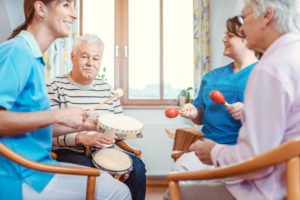The road traveled less (and less)
To all seniors: Take a hike.
To all caregivers: Make them do it—every day.
That hike can be as long or as short as physical abilities allow. Take a stroll around the community grounds. Walk down the hall to visit neighbors instead of phoning them. Shuffle all the way to the bathroom instead of using the potty chair. Residents who use wheelchairs can still dance with their hands. It's all good.
Mobility limitation will become a surging problem for senior living communities as the Greatest Generation is followed by the Couch Potato Generation and the Sim City Generation.
Mobility limitation is a devious, vicious circle: Not being able to move easily naturally fosters a slower, more sedentary lifestyle, which encourages muscle weakness, obesity, decreased pulmonary function and poor circulation—along with the host of chronic diseases that thrive among those conditions. Unfortunately, all those same factors also serve as the key contributors to mobility limitation, notes a clinical literature review published online Sept. 18 in JAMA.
The clinical review, which combed nearly 30 years of published research on seniors living in long-term care (LTC) communities, found that older age, lack of physical activity and obesity impacted mobility the most. But of special interest is the inclusion of mental health factors as well as the physical ones: An increasing loss of mobility also breeds social isolation and depression. Another study, published in February by the Annals of Internal Medicine, joins a growing body of research that connects low physical activity levels to faster cognitive decline among residents with dementia.
Preventing falls remains among the highest priorities for LTC communities, yet it turns out one of the best ways to prevent falls is to get up more often, another JAMA study (April 3, 2013) notes. Gentle but regular physical activity remains the #1 guardian against the unholy trinity of an unsteady gait, poor balance and mobility degradation.
Therapeutic exercises are fine, but they’re not nearly as effective as regular balance and resistance exercises, the study concluded. Physical therapy allows trained professionals to assess residents and their current abilities, while mapping an individualized path to increased mobility. That doesn’t mean the only time residents need to move is during their PT/OT sessions.
While the industry has spent decades developing excellent mobility-assistive devices, perhaps some of those tools are used a bit often, simply because it makes things easier or faster.
A note to the hale and less-old readers who may think this message doesn’t apply to them (yet): Our generation is the one that invented that clever assistive device called the “RoboStir.” (Perhaps ask “Siri” to look that up for you?)

Pamela Tabar was editor-in-chief of I Advance Senior Care from 2013-2018. She has worked as a writer and editor for healthcare business media since 1998, including as News Editor of Healthcare Informatics. She has a master’s degree in journalism from Kent State University and a master’s degree in English from the University of York, England.
Related Articles
Topics: Activities , Alzheimer's/Dementia , Clinical , Rehabilitation











